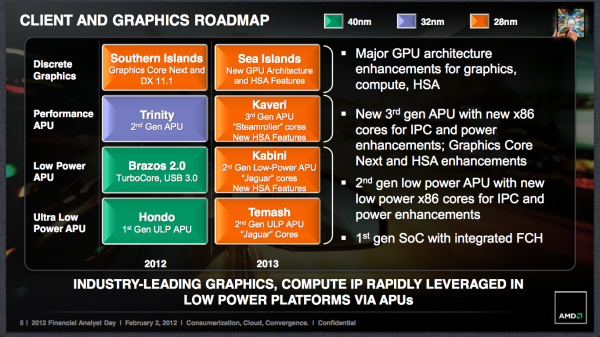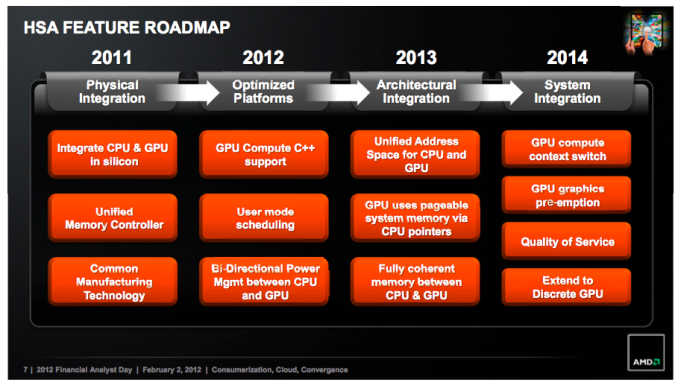AMD Radeon HD 7790 Review Feat. Sapphire: The First Desktop Sea Islands
by Ryan Smith on March 22, 2013 12:01 AM EST- Posted in
- GPUs
- AMD
- Sapphire
- GCN
- Radeon HD 7000
Bonaire’s Microarchitecture - What We’re Calling GCN 1.1
With our introduction out of the way, before looking at the cards and our performance results we would like to dive into a technical discussion and a bit of nitpicking. Specifically we would like to spend some time talking about architectures and product naming, as it’s going to be a bit confusing at first. As AMD has stated numerous times in the past, Graphics Core Next is a long-term architecture for the company. AMD intends to evolve GCN over the years, releasing multiple microarchitectures based on GCN that improve the architecture and add features while still being rooted in the design principles of GCN. GCN is after all the other half of AMD’s upcoming HSA-capable APUs, the culmination of years of AMD’s efforts with HSA/Fusion.
So where does Bonaire fit in? Bonaire is of course a GCN part; it’s a new microarchitecture that’s technically different from Southern Islands, but on the whole it’s a microarchitecture that’s extremely close in design to Southern Islands. In this new microarchitecture there are some changes – among other things the new microarchitecture implements some new instructions that will be useful for HSA, support for a larger number of compute work queues (also good for HSA) and it also implements a new version of AMD’s PowerTune technology (which we’ll get to in a bit) – but otherwise the differences from Southern Islands are very few. There are no notable changes in shader/CU efficiency, ROP efficiency, graphics features, etc. Unless you’re writing compute code for AMD GPUs, from what we know about this microarchitecture it’s likely you’d never notice a difference.
Unfortunately AMD has chosen to more-or-less gloss over the microarchitectural differences altogether, which is not wholly surprising since they will be selling Bonaire and previous generation products side-by-side. Bonaire’s microarchitecture has no official name (at least not one AMD wants to give us) and no version number. The Sea Islands name we’ve been seeing thrown around is not the microarchitecture name. Sea Islands is in fact the name for all of the GPUs in this wave – or perhaps it would be better to say all of the products created in this development cycle – including both Bonaire and it’s new microarchitecture, and Oland, AMD’s other new GPU primarily for mobile that is purely Southern Islands in microarchitecture.

In fact if not for the fact that AMD released (and then retracted) an ISA document called “AMD Sea Islands Instruction Set Architecture” last month, we would likely know even less about Bonaire’s microarchitecture. The document has been retracted at least in part due to the name (since AMD will not be calling the microarchitecture Sea Islands after all), so as a whole AMD isn’t particularly keen in talking about their microarchitecture at this time. But at the same time from a product standpoint it gives you an idea of how AMD is intending to smoothly offer both Southern Islands and Bonaire microarchitecture parts together as one product family.
Anyhow, for the sake of our sanity and for our discussions, in lieu of an official name from AMD we’re going to be retroactively renaming AMD’s GCN microarchitectures in order to quickly tell them apart. For the rest of this article and in future articles we will be referring to Southern Islands as GCN 1.0, while Bonaire’s microarchitecture will be GCN 1.1, to reflect the small changes between it and the first rendition of GCN.
Ultimately the differences between GCN 1.0 and GCN 1.1 are extremely minor, but they are real. But despite our general annoyance in how this has been handled, for consumers the difference between a GCN 1.0 card like the 7770 and a GCN 1.1 card like the 7790 should be limited to their innate performance differences, and of course PowerTune. GCN 1.1 or not, Bonaire fits in nicely in AMD’s current product stack and is in a position where it’s reasonable for it to be lumped together with GCN 1.0 parts as a single family. It’s really only the technical enthusiasts (like ourselves) and programmers that should have any significant reason to care about GCN 1.0 versus GCN 1.1. For everyone else this may just as well be another Southern Islands part.











107 Comments
View All Comments
Parhel - Monday, March 25, 2013 - link
Well said, and thanks. I no longer visit Dailytech for the same reasons. I enjoy reading comments, since they can offer other perspectives from like-minded people, but unmoderated is worse than nothing at all. This used to be my favorite tech site, but the comments section here has slowly been pushing me to avoid it most of the time.medi01 - Monday, March 25, 2013 - link
Suddenly Fermi is forgotten and it's only now that AMD will edge out nVidia on power efficiency.silverblue - Monday, March 25, 2013 - link
The 7790 reminds me of the 4770. Sure, that was on a new process node, but it's a late addition to the line designed to take advantage of tweaks, process improvements, etc.There may be a lot of transistors in a GCN design but I couldn't help feel that there were power savings to be had. For this reason, I'd hope that their next flagship doesn't exceed the 7970GE's power draw whilst providing a decent performance boost.
Lucian2244 - Tuesday, March 26, 2013 - link
Good article, very detailed.I think NVidia is replying to this with the new 650 Ti Boost.
Oxford Guy - Tuesday, March 26, 2013 - link
1 GB VRAM is ridiculous, especially for a $150 product.ericore - Thursday, March 28, 2013 - link
For those who want the most power in the smallest package and power drain, look no further then the Radeon 7790. The only disappointment was the heat factor, but more or less the same performance as 7850 at half the power; that's great. Also, I don't mind that AMD went the 6 ghz vram route, because now there is even more reason to get 2 GB which is especially needed if you apply a dozens or hundreds of mods to your games. Also its the 128 bit interface that kept the power low, so despite everyone's cussing AMD made the right choices. I have a GTX 460 which easily uses at least 200 watts. This 7790 is almost twice as fast and uses 2.5 times less power. The pricing is acceptable, if you were to include 2GB by default, then why bother with the 7850; they still want ppl to buy that one.slickr - Tuesday, April 9, 2013 - link
Hey Anand, can you guys please do a video quality test? I mean I haven't seen any such test on any website for over 3 years. So please, can you do a video quality test in movies and games and please also use low quality video as well, not just top of the line 1080p type videos that would look amazing even on a GeForce 3.